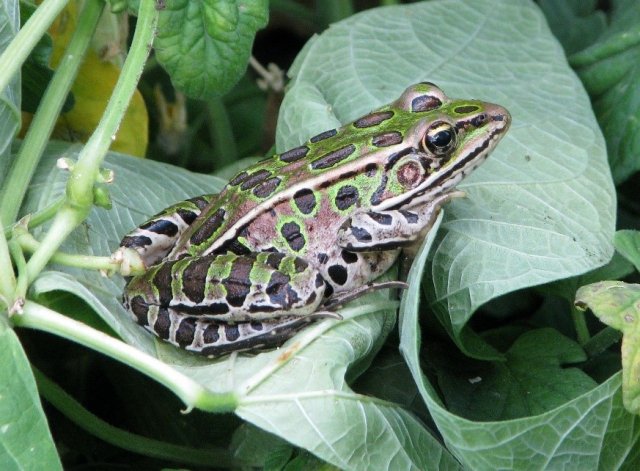How Do Pesticides Affect Frogs? EPA Researchers Conduct Uptake and Toxicity Studies to Find Out

Published July 19, 2022
Pesticides are frequently used in agriculture to promote strong, productive crops. However, once these chemicals are introduced into the environment, they have the potential to affect mammalian, aquatic, and amphibian species and other animals not originally intended for the pesticide’s use. Global research efforts indicate that pesticides have contributed to declining amphibian populations over the last few decades. To help address this problem, EPA scientists have conducted multiple studies over a 10-year period to better understand how pesticides affect juvenile and adult frogs.
Frogs have unique contamination routes and can be directly and indirectly exposed to pesticides throughout different stages of their life cycles. They begin their lives as tadpoles living in water. Once they grow legs and lose their tails, most migrate onto land. Frogs spend most of their time on land, but most must come back to the water to breed, and pesticide exposure can frequently occur during this critical life period.
In conducting this research, EPA scientists examined both pesticide body burdens and changes to the metabolomic profiles of the frogs. Body burdens are assessed by identifying the concentration of pesticides that move past a frog’s dermal barrier and into its blood stream and organs. Once pesticides pass the skin layer, they are likely to change the normal biochemistry of the frog, and researchers can collect metabolomic profiles in the laboratory using gas chromatography coupled with mass spectrometry (GC-MS). These biochemical profiles allow researchers to understand changes in the frogs’ metabolisms and identify any abnormal information that signifies something is wrong.
"Metabolomics is like taking pictures of a frog's biochemistry to understand the perturbations that the pesticides are causing and will hopefully give us the ability to predict if overt toxicity is likely to occur," said EPA scientist Matthew Henderson, a research lead for this study. "Think of when you go to the doctor and they take your blood to measure for certain ‘normal’ biochemical parameters, like high cholesterol. You have just undergone a metabolomic profile and the results of your bloodwork can warn of potential problems."
When conducting these metabolomic profiles, EPA scientists focused on analyzing the liver metabolome since it is integrally involved in pesticide toxicity and metabolism. The researchers began by analyzing how frogs react when exposed to a single pesticide. Their research then progressed to studying how multiple pesticides and other agrochemicals interact with the frogs’ biochemical profiles. In one study, researchers found that the frogs had increased pesticide concentrations when they were exposed to pesticides in water compared to exposure on contaminated soil. This finding could be important because frogs would be at higher risk during their breeding season.
In other research, Henderson and colleagues looked at how frogs responded to predation stressors with and without exposure to pesticides. In this research, the scientists exposed southern leopard frogs to bullfrogs, a known predator, to see if the presence of pesticides in the leopard frogs’ environment elicited different responses from them when they were stressed by seeing the bullfrogs. The scientists found that frogs exposed to pesticides and predator stressors had higher corticosterone levels and metabolites when compared to single exposures.
"It's important to study predation stressors when looking at how non-target organisms are affected by pesticides since it serves as an extension of our understanding for what a pesticide would do out in the real world," Henderson said. "It’s necessary to understand since frogs will never be exposed to one thing at a time and we want to mimic these real-world scenarios."
EPA’s aquatic research on frogs was conducted in controlled laboratory settings. However, EPA scientists have also started exploring non-lethal research methods that can be used in the field. Additionally, EPA scientists are embarking on research that investigates how salamanders are affected by pesticides to better understand how all amphibians react to pesticide exposure.
"This research is important because we need to understand the consequences of pesticide exposure for non-target species, such as frogs and salamanders, to protect amphibian populations since so many currently face extinction," said Henderson. "In a perfect world, we can also use what we've learned from our lab-based studies to help protect wild populations of amphibians without having to test the biological response of all pesticides or chemicals."
Ultimately, more studies are needed that focus on the impacts of agrochemicals on land-based amphibians to better inform risk assessments, policies, and sustainable pesticide use practices.
Related Publications:
Applying metabolomics to differentiate amphibian response to multiple stressors
Learn More:
